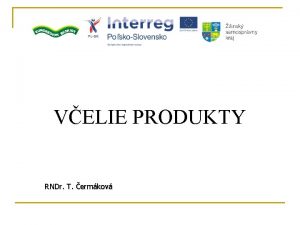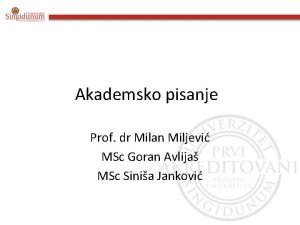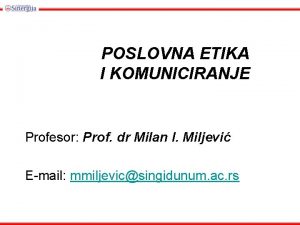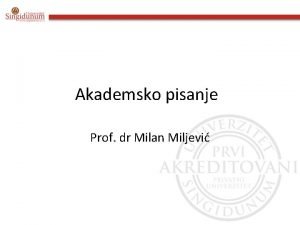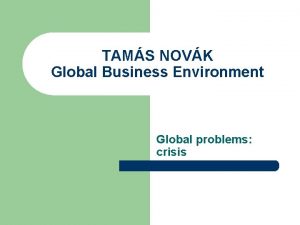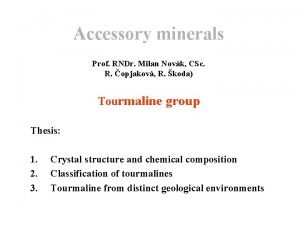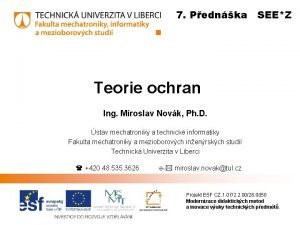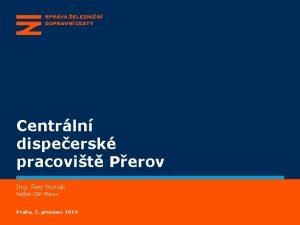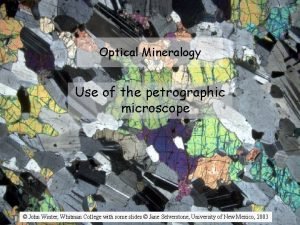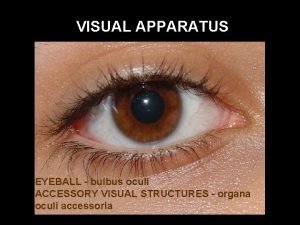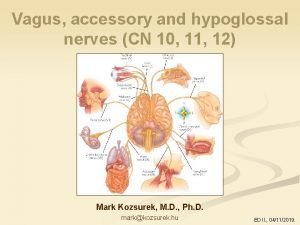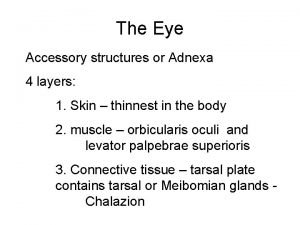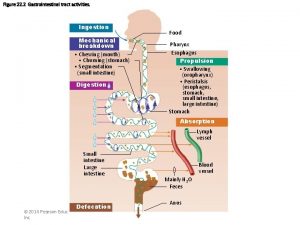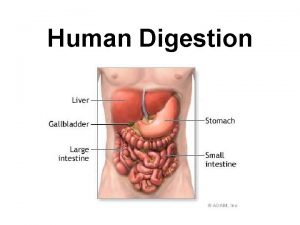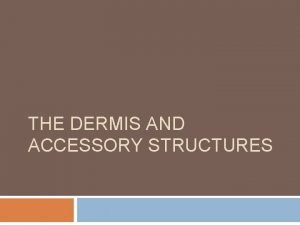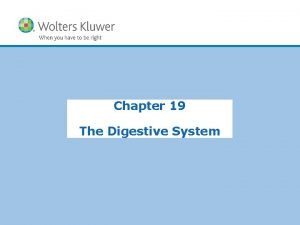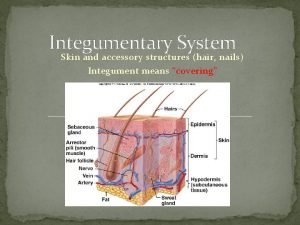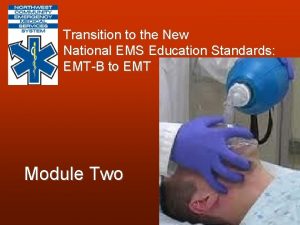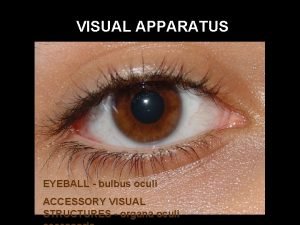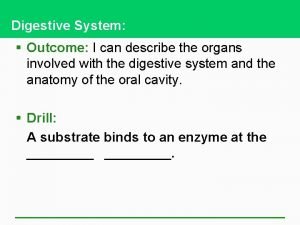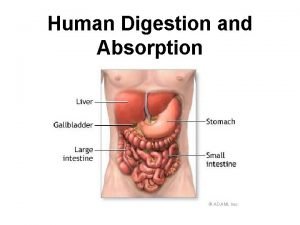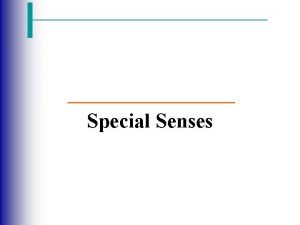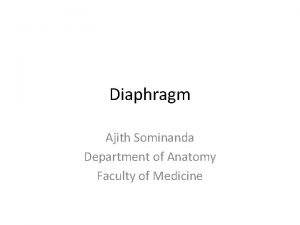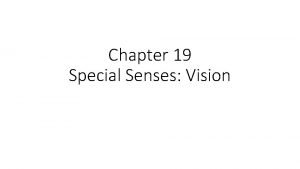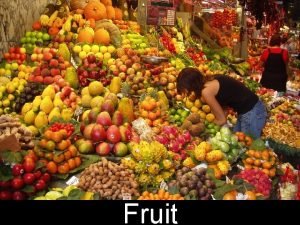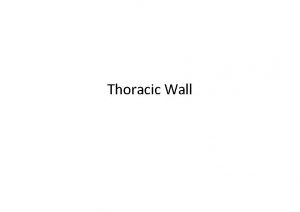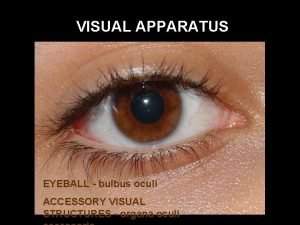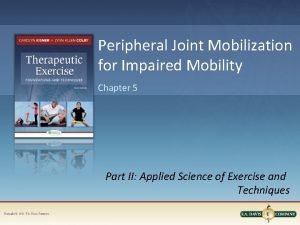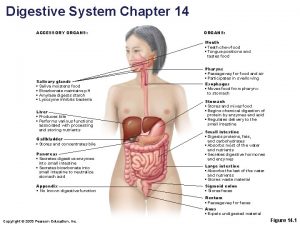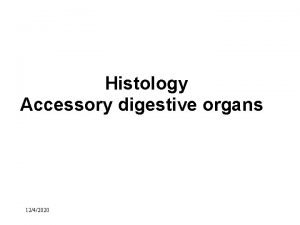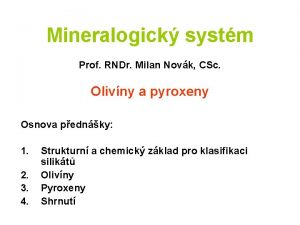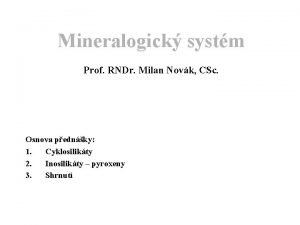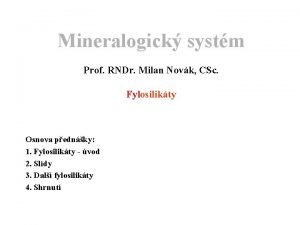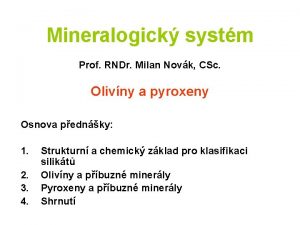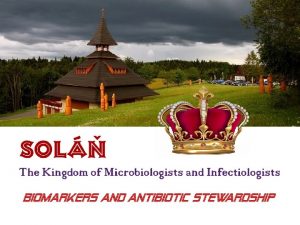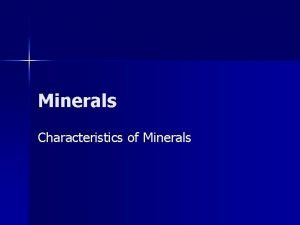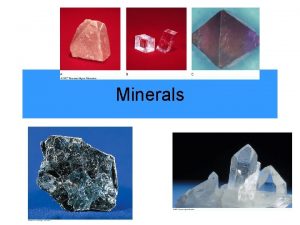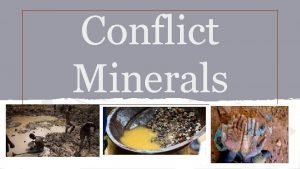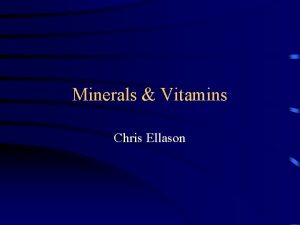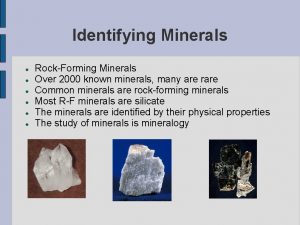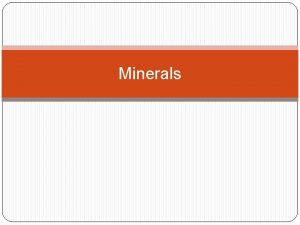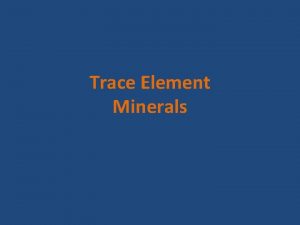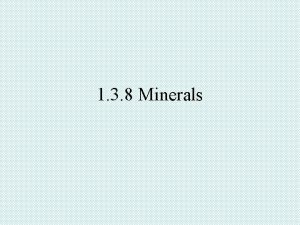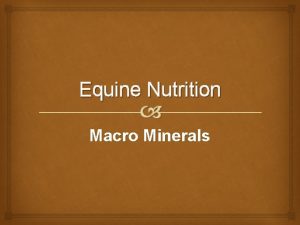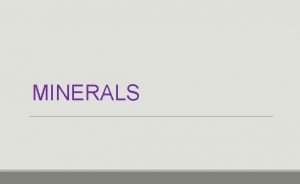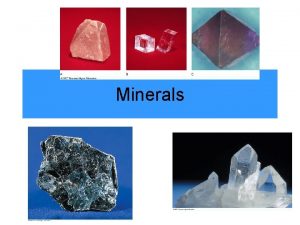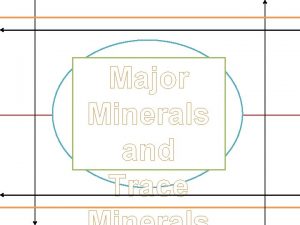Accessory minerals Prof RNDr Milan Novk CSc R





































- Slides: 37

Accessory minerals Prof. RNDr. Milan Novák, CSc. R. Čopjaková, R. Škoda) Tourmaline group Thesis: 1. 2. 3. Crystal structure and chemical composition Classification of tourmalines Tourmaline from distinct geological environments

1. Crystal structure and chemical composition • Minerals of tourmaline group (chiefly dravite and schorl) are the most abundant minerals with substantial amount of B in rocks of Earth crust. This is controlled by high stability field in PTX-conditions and high mechanical and chemical refractority. • Refraktory properties, presence of tourmaline in many rocks with highly variable chemical composition and crystal structure are the main reasons why tourmaline is one of the most examined mineral in last decades.

1. Crystal structure and chemical composition • Tourmaline belongs to cyklosilicates, trigonal, space group R 3 m. Acentric structure controls polar development of crystals and pyroelektric and piezoelectric properties. General formula: X Y 3 Z 6 T 6 O 18 (BO 3)3 V 3 W X = Na*, Ca, �, K Y = Mg, Fe 2+, Li, Al, Fe 3+, Mn, Zn, Cr 3+, V 3+, Ti 4+, (�) Z = Al, Mg, Fe 3+, Cr 3+, V 3+ T = Si, Al, B B = B V = OH, O W = OH, F, O Additional minor elements: Cu, Pb, Ni, Sr, Ba, Bi, Cl.

1. Crystal structure and chemical composition • Substitutions: • monovalent: YMg = YFe 2+ WOH = WF ZAl = ZFe 3+ XNa = XK • heterovalent: 2 YFe 2+ = YLi + YAl XNa + YAl = XCa + YMg XNa + YMg = X� + YAl YMg + VOH = YAl + VO X� + YAl + WOH = XCa + YMg + WO 2 YMg + ZAl + WOH = 2 YAl + ZMg + WO • heterovalent substitutions predominate. The last substitution leads to change in order/disorder (sites Y and Z).

1. Crystal structure and chemical composition

1. Crystal structure and chemical composition

1. Crystal structure and chemical composition X Y X X-O = 2. 51 -2. 78 Å Z Z-O = 1. 90 -2. 00 Å Y-O = 1. 95 -2. 11 Å T B T-O = 1. 60 -1. 64 Å

1. Crystal structure and chemical composition • Crystal structure (e. g. , short-range order) has essential infuence on chemical composition of tourmaline along with commonly considered chemical composition of parental medium (melt, hydrothermal fluids), chemical composition of associated minerals and P-T-X conditions. See occupation of W-site bymonovalent or divalent element. a) monovalent F or OH (see fig. 2 and 3) in the W-site implies the most suitable configurations in the Y – site are 3 Mg or Al + 2 Mg. accordingly divalent O Y - 3 Al or 2 Al + Mg. b) If monovalent F (but not OH) is in W-site X-site prefers Na. But only up to Ca (> ~0, 2 apfu).

1. Crystal structure and chemical composition

1. Crystal structure and chemical composition • Analogically occupation on V-site (OH nebo O) controls configuration of cationts in the Z-site. • In nature, the following conmpositions are most common controlled by crystal structure: • dravite-schorl Na 0, 5� 0, 5 (Mg, Fe 2+)2 Al Al 6 (BO 3)3 Si 6 O 18 (OH)3 (OH)0, 5 O 0, 5 • elbaite Na 0, 5� 0, 5 Li Al 2 Al 6 (BO 3)3 Si 6 O 18 (OH)3 (OH)0, 5 O 0, 5

2. Classification of tourmalines • The latest Classification of the tourmaline group minerals was approved by the CNMMN of IMA in 2008. • The Subcommission for classification of the tourmaline group minerals was established at the Commission for New Minerals and Mineral Classification of the IMA at 2002, and currently this commission involves: M. Novák - Masaryk University, Brno – chairman D. Henry – University of Louisiana, Baton Rouge – vicechairman Members: B. Dutrow - University of Louisiana, Baton Rouge A. Ertl – University of Vienna F. C. Hawthorne – University of Manitoba, Winnipeg F. Pezzotta – Museum of Natural History, Milano P. Uher – Komensky University, Bratislava

2. Classification of tourmalines • • Complications: commonly undetermined B, H, Li, F, Fe 2+ a Fe 3+ on electron microprobe. X-site: Na – Ca – � (see amphibols) W-site: OH – F – O (problematic) V-site: OH – O (problematic) Y-site: Mg – Fe 2+ – (Li+Al) – Al Z-site: Al – Fe 3+ – Cr – V

2. Classification of tourmalines General formula X Y 3 Z 6 T 6 O 18 (BO 3)3 V 3 W Elbaite Schorl Dravite Olenite Chromdravite Vanaddravite Buergerite Povondraite Liddicoatite Uvite Hydroxyferuvite Rossmanite Foitite Magnesiofoitite Na Na Ca Ca Ca Li 1. 5 Al 1. 5 Fe 2+3 Mg 3 Al 3 Mg 3 Fe 3+3 Li 2 Al Mg 3 Fe 2+3 Li. Al 2 Fe 2+2 Al Mg 2 Al Al 6 Cr 6 V 6 Al 6 Fe 3+4 Mg 2 Al 6 Mg. Al 5 Al 6 Si 6 O 18 Si 6 O 18 Si 6 O 18 Si 6 O 18 (OH) (OH) F O F F (OH) (BO 3)3 (BO 3)3 (BO 3)3 (BO 3)3 (OH)3 (O)3 (OH)3 (OH)3

2. Classification of tourmalines

2. Classification of tourmalines

Formula calculations • Based on general formula but due absence of information about light-elements contents in most analyses - complicated. • If all elements determined (very rare example), from general formula. • Data from electron microprobe – Si, Ti, Al, Fetot, Mg, Mn, Ca, Na, K, F, Cr, V, Zn), several distinct approaches exist (Henry and Dutrow 1996, Dutrow and Henry 2000).

Formula calculations • Normalization on 6 Si apfu. Simplification but easy and potential errors are recognizeable. For geochemical studies sufficient. • If tourmaline is Li-enriched then normalization Li = 3 – Y (where Y = YAl + Fe + Mg + Mn + Zn). This way expect no vacancy in this site, which is not necessary true. Moreover, valency of Fe is a compolication, hence commonyl amount of Li is overestimated. • In both cases B = 3 from stoichiometry.

Grafical diagrams of tourmaline composition First, we have to define if our diagrams should show geochemical features or crystalographical features.

Grafical diagrams of tourmaline composition

Grafical diagrams of tourmaline composition

3. Tourmaline from different geological environments • Tourmaline in granites Tourmaline is a typical mineral of peraluminous mostly leucocratic granites. Its presence in rock is limited by: content of B in melt content of Al in melt(ASI index) activity of Mg, Fe activity of H 2 O, f. O 2 (London 1999, Dingwell et al. 1996). • 2 wt. . % B 2 O 3 and acidic conditions. Most of B commonly leave granite and react with host rocks.

3. Tourmaline from different geological environments Lavičky

3. Tourmaline from different geological environments a) b) 2 examples of tourmaline from granites, a) accessory, b) nodules

3. Tourmaline from different geological environments Chemical composition of tourmaline from distinct granites.

3. Tourmaline from different geological environments • Tourmaline in granitic pegmatites • Formation of tourmaline is similar to granites in simple pegmatites. • Transition for magmatic to hydrothermal crystallization is indicated by distinct change in chemical composition - foitite and Li-tourmalines (elbaite-schorl) with elevated Mg, Ca and Fe.

3. Tourmaline from different geological environments

3. Tourmaline from different geological environments

3. Tourmaline from different geological environments • Tourmalines from hydrothermal systems • Tourmalines are common in distinct mineral assemblages occurring in hydrothermal veins and the source of B is commonly granite pluton. In stratiform deposits, source of B are volcanic exhalates or evaporites. Concentration of B in fluids is much lower relative to granitic melt to stabilize tourmaline. • Typical feature of hydrothermal tourmaline – oscillatory zoning.

3. Tourmaline from different geological environments Brněnský pluton 1 – turmalín v trondhjemitech, 2 – turmalín v ryolitech, 3 – turmalín v hydrotermálních žilách prorážejících diority, 4 - turmalín v hydrotermálních žilách prorážejících granity, 5 – turmalín na puklinách amfibolitů a dioritů.

3. Tourmaline from different geological environments • Tourmaline from stratiform deposits and tourmalinites • Tourmaline is a common mineral ín stratiform deposits with highly variable textures and grain size. • Source of B - volcanic exhalates or evaporites, solutions from bazalts, clastic rocks. Tourmaline crystallized at low T of diagenesis at about 200 °C, when B is released from phylosilicates. • Tourmalinites (10 -20 vol. % of tourmaline) are similar to stratiform deposits. • schorl-dravite-uvite-buergerite (Slack 1996).

3. Tourmaline from different geological environments • Tourmaline from metamorphic rocks • Tourmalines are similar to tourmalůineites and stratiform deposits but they show more variable composition. B is released from phylosilicates during prograde metamorphism. At high T, potential source of B is muscovite. Boromuscovite is stable at higher P relative to muscovite, hence during drop of P B is released from mica. • Well-developed zoning is product of continuous reactions, when B is released from clay minerals, homogeneous tourmaline formed during discontinual reactions. • schorl-dravite-uvite-buergerite chromdravite, vandiumdravite, magnesiofoitite.

3. Tourmaline from different geological environments Metamorphic rocks Partitioning of the individual elements • Y-site: Mg: decrease XMg • Metapelites medium grade tourmaline > cordierite > chlorite > biotite > staurolite > garnet > ilmenit • metapelites high grade tourmaline, cordierite > biotite > safiríne Li: decrease XLi • Metapelites medium grade staurolite > cordierite > biotite> muskovite > garnet, tourmaline, chloritoid • metapelites high grade kornerupine >> safiríne > biotite > cordierite > muskovite > tourmaline, plagioclase, garnet, ortopyroxene

3. Tourmaline from different geological environments • X-site: Na: pokles XNa • Metapelites medium grade tourmaline > plagioclase • metapelites high grade tourmaline, pargasite, scapolite > serendibite > plagioclase, clinopyroxene • W-site: F: decrease XF • metapelites high grade tourmaline > biotite > kornerupin • Calc-silicates high grade tourmaline, clinohumite > tremolite/pargasite > flogopite > talc Tourmaline is generally enriched in Mg, Na and F and depleted in Ca and Li.

3. Tourmaline from different geological environments Chýnov-mramor

3. Tourmaline from different geological environments Detrital tourmaline as indicator of clasts provenience

3. Tourmaline from different geological environments

4. Conclusions Minerals of tourmaline group are very interesting and highly useful for study of different geological problems.
 Medovica
Medovica Rndr
Rndr Prof dr milan miljevic
Prof dr milan miljevic Prof dr milan miljevic
Prof dr milan miljevic Prof dr milan miljevic
Prof dr milan miljevic Novk
Novk Novk
Novk Novk
Novk Novk
Novk Novk
Novk Cdp přerov
Cdp přerov Edinger westphal nucleus
Edinger westphal nucleus Gypsum plate retardation
Gypsum plate retardation Bulbus oculi
Bulbus oculi Pirogovs triangle
Pirogovs triangle Cranial nerves 346
Cranial nerves 346 Accessory structure of the eye
Accessory structure of the eye Microscopic anatomy of stomach
Microscopic anatomy of stomach Where is bile stored
Where is bile stored Accessory visual structures
Accessory visual structures Accessory structure of the skin
Accessory structure of the skin Accessory organs of the digestive system
Accessory organs of the digestive system Integumentary accessory organs
Integumentary accessory organs What are accessory muscles
What are accessory muscles Accessory visual structures
Accessory visual structures Teat
Teat Internal organs
Internal organs Which is an accessory organ of the digestive system
Which is an accessory organ of the digestive system Accessory structures of the eye
Accessory structures of the eye Cupola in diaphragm
Cupola in diaphragm Fig 19
Fig 19 Accessory fruit
Accessory fruit Accessory muscles
Accessory muscles Enophtalmus
Enophtalmus Non-thrust oscillation techniques
Non-thrust oscillation techniques Figure 14-1 digestive system
Figure 14-1 digestive system What is accessory pigment
What is accessory pigment Hemopoeisis
Hemopoeisis
